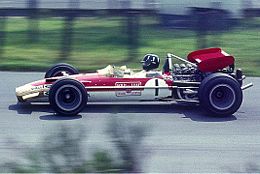
Back Lotus 49 German Lotus 49 Spanish Lotus 49 Finnish Lotus 49 French Lotus 49 Italian ロータス・49 Japanese Lotus 49 Polish Lotus 49 Russian Lotus 49 Slovenian Lotus 49 Swedish
 | |||||||||||
| Category | Formula One | ||||||||||
|---|---|---|---|---|---|---|---|---|---|---|---|
| Constructor | Lotus | ||||||||||
| Designer(s) | Colin Chapman (Technical director) Maurice Philippe (Chief designer) | ||||||||||
| Predecessor | Lotus 43 | ||||||||||
| Successor | Lotus 63 / Lotus 72 | ||||||||||
| Technical specifications[1][2] | |||||||||||
| Chassis | Aluminium monocoque | ||||||||||
| Axle track | 1,524mm (60in) front and 1,549mm (61in) rear[3] | ||||||||||
| Wheelbase | 2,413 mm (95.0 in) | ||||||||||
| Engine | Ford Cosworth DFV, 2,998 cc (183 cu in), V8, NA, mid-mounted | ||||||||||
| Transmission | Hewland-Lotus 5-speed manual gearbox | ||||||||||
| Power | 420-440 hp @ 9,000-10,000 rpm[4] | ||||||||||
| Weight | 501 kg (1,105 lb) | ||||||||||
| Fuel | Esso (9 GP), Shell | ||||||||||
| Tyres | Firestone, Dunlop | ||||||||||
| Competition history | |||||||||||
| Notable entrants | Gold Leaf Team Lotus Rob Walker Racing Team | ||||||||||
| Notable drivers | |||||||||||
| Debut | 1967 Dutch Grand Prix | ||||||||||
| |||||||||||
| Constructors' Championships | 2 (1968, 1970^) | ||||||||||
| Drivers' Championships | 2 (Graham Hill, 1968 / Jochen Rindt, 1970) | ||||||||||
The Lotus 49 was a Formula One racing car designed by Colin Chapman and Maurice Philippe for the 1967 F1 season. It was designed around the Cosworth DFV engine that would power most of the Formula One grid through the 1970s. It was one of the first F1 cars to use a stressed member engine combined with a monocoque to reduce weight, with other teams adopting the concept after its success.[5] An iteration of it, the 49B, also pioneered the use of aerofoils to generate downforce.
Jim Clark won on the car's debut, in 1967, and it would also provide him with the last win of his career, in 1968. Graham Hill went on to win that year's title and the car continued winning races until 1970.
- ^ "STATS F1 • Lotus 49". Statsf1.com. Retrieved 26 January 2015.
- ^ "Lotus-Ford 49". grandprixhistory.org. 14 February 2011. Retrieved 26 January 2015.
- ^ "1967 Lotus Type 49 technical and mechanical specifications".
- ^ "Engine Ford Cosworth • STATS F1".
- ^ John Krewson (May 2013), "Fast, Present, Future: 1967 Lotus 49 vs. 2013 Corvette ZR1", Road and Track, retrieved 13 June 2013,
It used its drivetrain as a stressed member, being not the first F1 car to do so but the first to apply the technique so well that everyone copied it.